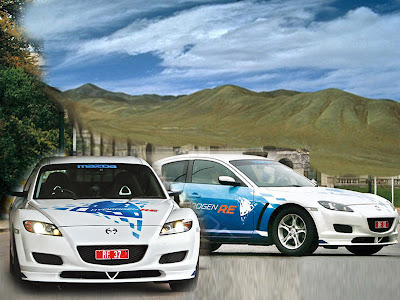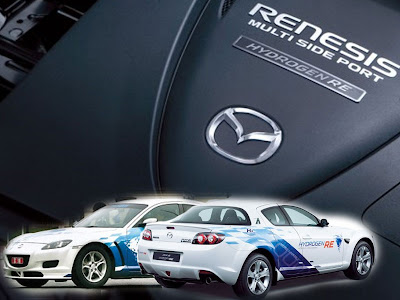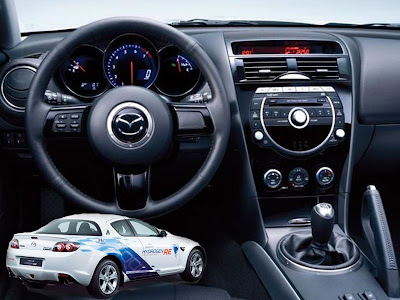 For the past seven years, the most important automotive design studios in Southern California compete in a Design Challenge organized by the Los Angeles Auto Show. For this year's edition of the show, which runs November 19-29, the event planners decided to add an international flavor to the contest by inviting studios from Germany and Japan to join the competition for the very first time.
For the past seven years, the most important automotive design studios in Southern California compete in a Design Challenge organized by the Los Angeles Auto Show. For this year's edition of the show, which runs November 19-29, the event planners decided to add an international flavor to the contest by inviting studios from Germany and Japan to join the competition for the very first time.
 The theme for the 2010 Design Challenge is the creation of a super-efficient and lightweight four-passenger car: "The objective is to envision an efficient, light-weight, four passenger vehicle (not to exceed 1,000 lbs.), that is both comfortable and safe, while delivering satisfactory driving performance without sacrificing the styling consumers demand. "
The theme for the 2010 Design Challenge is the creation of a super-efficient and lightweight four-passenger car: "The objective is to envision an efficient, light-weight, four passenger vehicle (not to exceed 1,000 lbs.), that is both comfortable and safe, while delivering satisfactory driving performance without sacrificing the styling consumers demand. "
Follow the break for the first group of concept models by Cadillac, Honda, Maybach and Mazda, and stay tuned for the second part.
___________________________CADILLAC AERA___________________________

1000lbs/1000mi
The Cadillac Aera (Aero + Era) launches Cadillac's philosophy of "Art and Science" into new territory by taking an innovative and stylistic approach to ultra-light weight vehicle design. Aera is a 1000 lb, 2+2 touring coupe, with a range of 1000 miles before refueling; attributes achieved without compromising size, capacity and safety.
Optimum efficiency, minimum parts
Aera's highly advanced body structure utilizes a 3D lattice, mono-formed frame. This polyhedral structure is similar to configurations found consistently in nature, e.g., inside the grouping of bubbles. The structure is formed from unique, alloy-utilizing, semi-solid freeform manufacturing, creating a naturally strong, extremely lightweight frame. All major body parts, including interior components, are essentially "grown" into a single part lattice structure.
Renowned Cadillac smoothness and quietness are accomplished using the harnessed power of compressed air via a highly efficient Pneumatic Drive System (PDS). Its 10,000 psi composite air storage tank has ample capacity for a 1000 mile range. Flexible, pressurized air cells in the exterior skin, similar to material developed for the NASA Mars Rover airbags, enhance passive safety and interior comfort. The flexible polymer skin optimizes aerodynamics and functions as an ultra-lightweight alternative to conventional body panels and glass.
Additional technologies include an All-In-One (AIO) wheel system, combining rotary actuator propulsion, steering and suspension functions. A drive by wireless system decreases the mass of electrical components. Vehicle to vehicle communication (V2V) promotes active safety.
The Cadillac Aera embodies a stylistic, lightweight, minimalist approach to long distance luxury touring.







________________________________________________________________________
_____________________________HONDA AIR_____________________________

The Honda Air concept is a vision of the future of lightweight and alternative fuel performance vehicles; a coastal cruiser for the aggressive lifestyle. Inspired by the modern roller coaster as well as skydiving wing-suits, the Air is powered by a compressed air and pneumatic regulator system. It utilizes turbo vacuums and external air-flow to regenerate tank pressure for extended range and increased boost for an estimated 100 miles. The chassis doubles as the master tank and all components, including seating, are mounted to the central chassis/tank to eliminate redundant structure and reduce overall weight.
Vegetable based polymer panels and fairings protect occupants, maintaining the solid Honda method; safety for everyone. The Air's cockpit and package maintain the aggressive human packaging of a modern roller coaster aimed at maximizing the open air experience. In order to reduce weight and increase dynamic performance, a hub-less wheel and drive system eliminates the use of heavy drive train components. Glass reinforced seating panels, urethane tire composition and skeletal sub-frame components combine for drastic weight savings. Using a Honda generator / air compressor at home or tire filler at your local filling station, the main tanks and reserves can be filled quickly and safely.
At just under 800 lbs., the powerful anthem of pneumatic propulsion and a character unlike any zero-emission vehicle exemplifies Honda's concept of fun to drive. The pow[air] of dreams.










________________________________________________________________________
___________________________MAYBACH DRS____________________________

MAYBACH DRS - "Den-Riki-Sha" (electric powered rickshaw)
Gracing the Roads of Tomorrow
A radically new car culture will arise in the near future, which is aligned with modern architecture, infrastructure and nature. An astonishing variety of future automotive designs will grow, commensurate, with newly available energy sources, drive systems and alternative production methods. Light, transparent designs with sculptured elegance and an extensive range of comfort and safety options are finding their way into a new eco-conscious world.
The MAYBACH DRS "Den-Riki-Sha" (electric powered rickshaw) embodies these attributes and leverages the traditional values of the classic "Jin-Riki-Sha" (human powered rickshaw), which originated in Tokyo circa 1870.
Breathtaking beauty, ingenious luxury and technical brilliance characterize the sophisticated development of the "DRS." This MAYBACH is the first worldwide NMV (Naturally Manufactured Vehicle). Its production process is unique: Per a highly perfected and complex metamorphosis, a readily developed car is born out of a coded DNA-cocoon. Organic intelligence, aligned with advanced bio-mechanical engineering skills, created this special process being designed for a limited number of exclusive vehicles. A futuristic composition of ultra-light construction with a unique luxurious Exterior & Interior expression.
Powered by a self balancing electric drive unit and controlled by an onboard computer that is plugged into a mega city's transport infrastructure, the MAYBACH DRS delivers a smooth, luxurious journey cross town. To extend its range, this human-electric hybrid allows pedaling power to be supplemented by the driver. Meanwhile, the passengers enjoy the journey in their glamorous surroundings.
MAYBACH traditionally pointed the way to a modern era of luxurious mobility – the "Den-Riki-Sha" continues this heritage, gracing the roads of tomorrow.









________________________________________________________________________
____________________________MAZDA MX-0_____________________________

ze·ro
-adjective: having no measurable quantity or magnitude
-noun: the lowest point or degree
Zero weight:
Mazda's long-time commitment to low weight is driven by the belief that effortless cornering and acceleration should be at the heart of every car we design. Our featherweight icon -- the MX-5 Miata, tipped the scales at a little over 2,300 pounds in its first generation. Starting with the MX-5 as a benchmark, the design team has carried out a systematic process of reduction and consolidation. In this process, we have redesigned each component in the MX-0 to carry out the functions of several MX-5 components, effectively replacing a multitude of MX-5 parts with fewer, simplified ones. Innovative lightweight materials have been used extensively to obsessively lower weight.
Zero carbon:
Aimed at the global market of 2020, and with projected volume of 500,000 units annually, the MX-0 would have positive effects on the world's environment and economy by way of less energy consumption and minimized use of raw materials. High-volume, automated manufacturing of sustainable, inexpensive composites coupled with clean-running drive trains are the key to both low weight and high-volume production.
Zero mass = maximum speed:
At the heart of the MX-0 is its purpose as a driving beast. Its ultra-light mass is pushed by high-torque electric motors. High power-to-weight is where a Mazda comes alive. Impossible acceleration and instant cornering is the result. It's more like flying than driving. Zero hindrance. Driving bliss.


















































